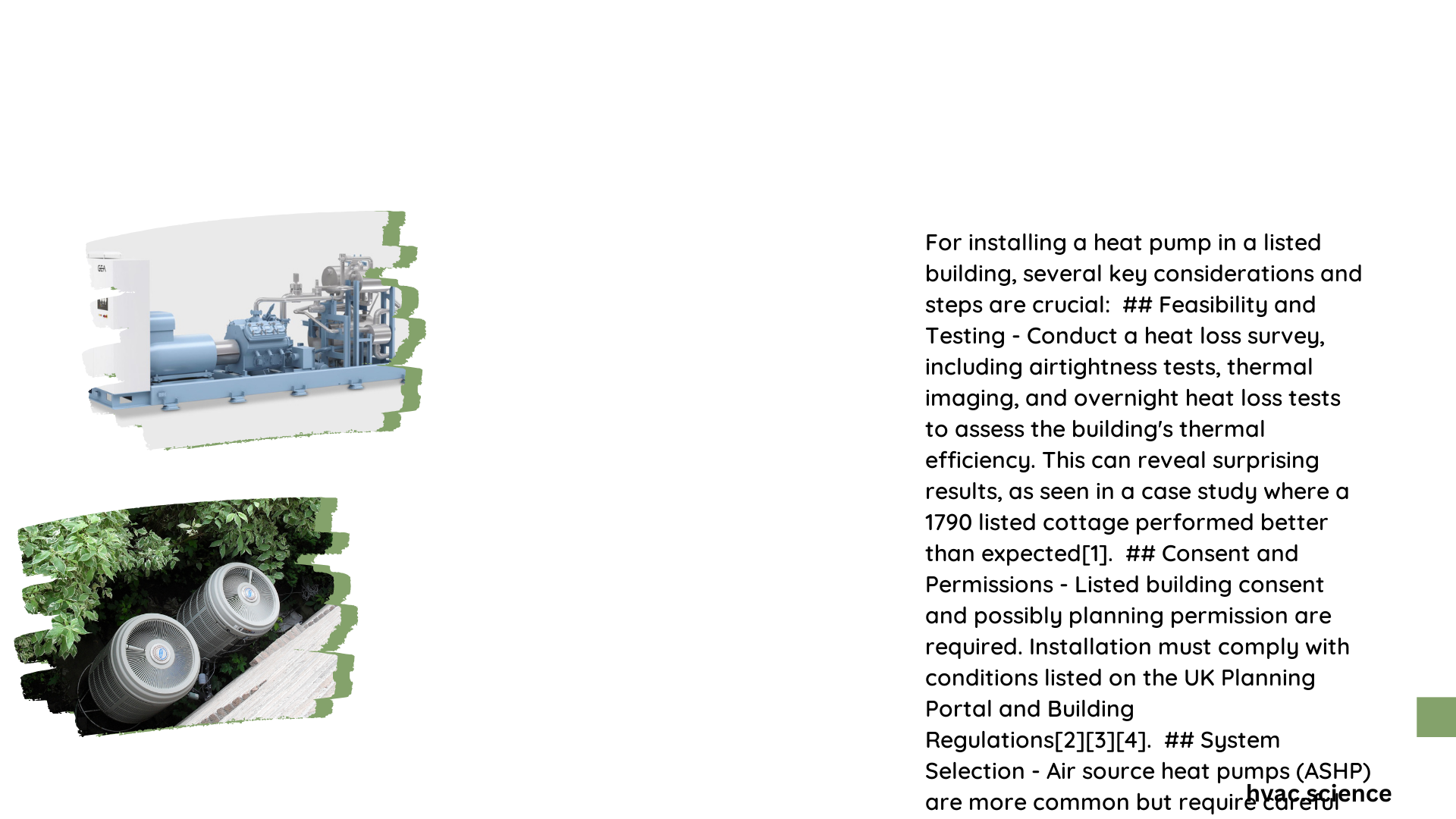Installing heat pumps in listed buildings presents unique challenges due to preservation requirements and structural considerations. This guide explores the specific requirements, regulations, energy efficiency aspects, and suitability of different heat pump types for listed properties. We’ll address key concerns for property owners and provide practical insights for successful heat pump integration in historic structures.
What Are the Specific Installation Requirements for Heat Pumps in Listed Buildings?
Installing heat pumps in listed buildings requires careful consideration of several factors:
- Structural Integrity Preservation
- Professional Advice
- Location and Visibility
- Reversibility of Installation
Structural Integrity Preservation
- Avoid measures causing physical damage to the building
- Be cautious of sudden heating in rarely used or previously unheated buildings
- Ensure installation doesn’t compromise the building’s historic fabric
Professional Advice
- Seek guidance from experts in older building physics and traditional craftsmanship
- Consult with conservation officers or heritage specialists
Location and Visibility
- Install heat pumps in locations that minimize visual impact
- Avoid front-facing installations or placements in protected interiors
- Prefer rear property locations or yards
- Ensure sufficient space for proper airflow
Reversibility of Installation
- Opt for installations that can be removed without permanent alterations to the building
- Choose methods that allow for future removal or replacement
What Regulations and Permits Are Necessary for Heat Pump Installation in Listed Buildings?

Several regulations and permits are required when installing heat pumps in listed buildings:
- Listed Building Consent
- Compliance with Local and National Legislation
- Specific Permit Requirements
- Restrictions on Modifications
Listed Building Consent
- Contact local authority for consent
- Arrange joint inspection with heat pump installer and property owner
Compliance with Legislation
- Adhere to relevant acts such as:
- Cultural Heritage Act
- Planning and Building Act
- Svalbard Environmental Protection Act (where applicable)
Specific Permit Requirements
- Check local jurisdiction requirements
- Example: Montreal requires a permit and specific technical specifications
Restrictions on Modifications
- Additional consents may be needed for:
- Raising floor levels
- Changing skirtings, doors, or steps for underfloor heating
How Do Heat Pumps Perform in Terms of Energy Efficiency in Listed Properties?
Energy efficiency of heat pumps in listed buildings can be assessed through various metrics:
- Heat Loss Surveys
- Expected Performance Metrics
- Energy Savings and Cost-Effectiveness
Heat Loss Surveys
| Survey Type | Purpose |
|---|---|
| Airtightness Tests | Measure building’s air leakage |
| Thermal Imaging Assessments | Identify heat loss areas |
| Overnight Heat Loss Tests | Evaluate overall thermal efficiency |
Example: A listed cottage from 1790 with uninsulated stone walls and single-glazed windows achieved a thermal efficiency rating of 1.75, surpassing typical older homes.
Expected Performance Metrics
- A 7kW heat pump can often meet existing heating demands in older properties
- Efficiency varies based on building characteristics and insulation levels
Energy Savings and Cost-Effectiveness
- Heat pumps generally offer significant energy savings compared to traditional systems
- Carbon emissions and fuel bills can be reduced
- Exact savings depend on specific building factors and insulation quality
Which Types of Heat Pumps Are Most Suitable for Listed Buildings?
Different heat pump types have varying suitability for historic buildings:
- Air-Source Heat Pumps
- Ground-Source Heat Pumps
Air-Source Heat Pumps
Pros:
– Relatively simple installation
– Minimal impact on building structure
– Often the most feasible option for listed buildings
Cons:
– Require sufficient space for airflow
– Can be noisy (though quieter models are available)
– Visual impact needs consideration
Ground-Source Heat Pumps
Pros:
– Generally quieter operation
– Can be more efficient in some cases
Cons:
– Extensive installation process
– Potential impact on building grounds
– Usually not considered permitted development in listed buildings
– May require additional consents and environmental assessments
What Are the Key Considerations for Noise and Aesthetic Impact?
When installing heat pumps in listed buildings, noise and aesthetic factors are crucial:
- Noise Levels
- Choose models with lower noise output
- Consider placement away from living areas or neighbors
-
Use acoustic barriers if necessary
-
Aesthetic Impact
- Select less visible locations for installation
- Consider screening options that complement the building’s architecture
- Consult with conservation officers on acceptable placement and design
By carefully addressing these aspects, it’s possible to successfully integrate heat pumps into listed buildings while preserving their historic character and meeting modern energy efficiency standards.
